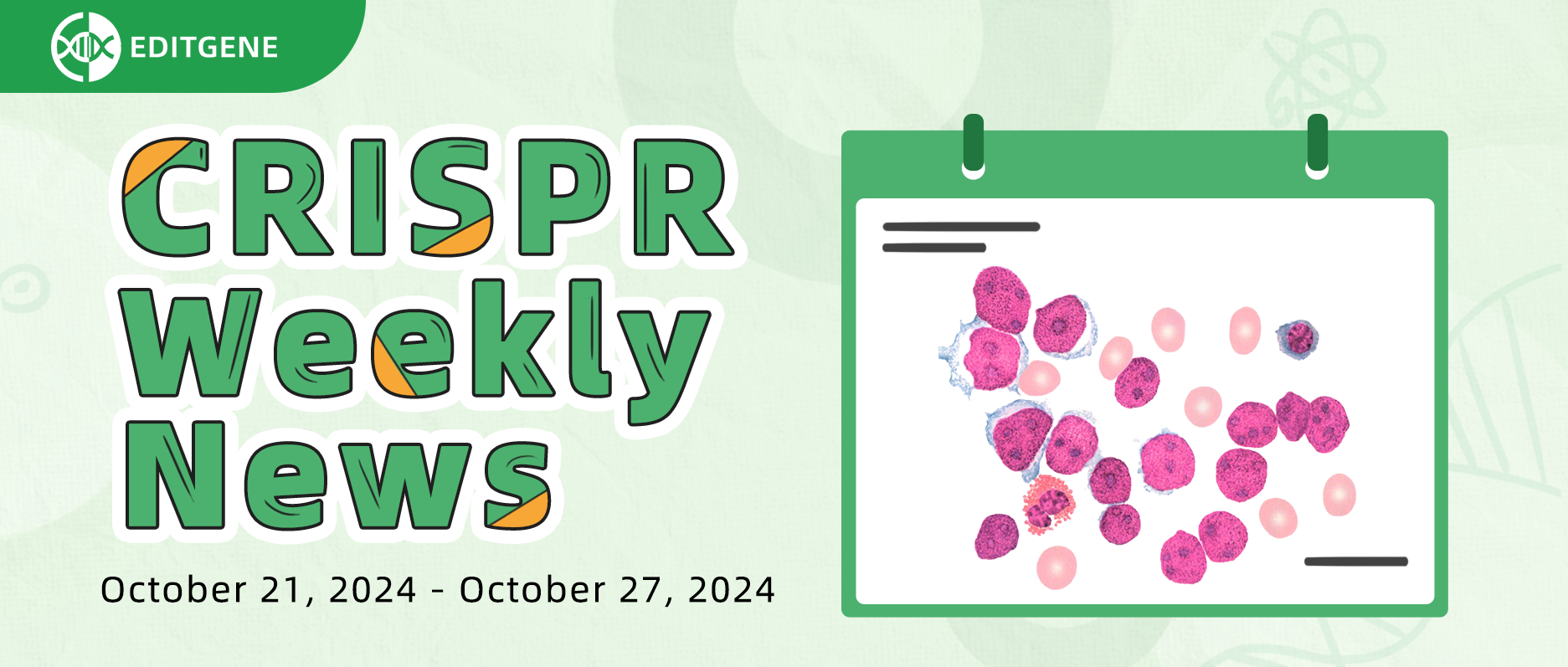[Weekly News]CRISPR/Cas9 Gene Knockout: A New Strategy to Overcome Immune Therapy Resistance in Neuroblastoma

CRISPR/Cas technology is a revolutionary tool in modern biological sciences, with applications spanning medicine, agriculture, environmental conservation, and more. New findings and case studies continue to emerge across these fields. Our ‘CRISPR Weekly News’ column brings you the latest research and industry updates. Here's a brief summary of the past week's highlights:
I. Research Updates
1.Title:ZC3H14 facilitates backsplicing by binding to exon-intron boundary and 3' UTR
Journal:Mol Cell (Impact Factor: 14.5)
Original Link: https://doi.org/10.1016/j.molcel.2024.10.001
Circular RNA (circRNA) is a natural product of eukaryotic transcription and RNA processing. It has emerged as a key regulatory factor in both physiology and disease. Various cis-elements and trans-factors have been reported to regulate circRNA biogenesis through back-splicing, however, most of these regulations occur within the flanking introns of circRNA.
In a recent study, researchers conducted a whole-genome CRISPR knockout screening to identify an evolutionary conserved RNA-binding protein called ZC3H14. This protein plays a significant role in circRNA biogenesis. The results revealed that specific RNA sequences bind significantly to ZC3H14, suggesting these sequences are important for its function in promoting back-splicing.
Moreover, the study showed that overexpression of ZC3H14 significantly increased circRNA generation, while knocking down ZC3H14 reduced its yield. ZC3H14 enhances the accessibility of critical sites needed for back-splicing by promoting conformational changes in RNA. These findings clarify the conserved role of ZC3H14 in regulating back-splicing and establish a connection between ZC3H14, circRNA biogenesis, and male fertility.
2.Title:The prominent pervasive oncogenic role and tissue specific permissiveness of RAS gene mutations
Journal:Scientific Reports (Impact Factor: 3.8)
Original Link: https://doi.org/ 10.1038/s41598-024-76591-8
In cancer research, RAS biology has primarily focused on a limited number of tumor types. Although RAS genes are suspected to be common factors of various cancers, strong evidence is still needed to establish their critical oncogenic significance. Researchers conducted a data mining study using DepMap whole-genome CRISPR screening data. This study provides substantial evidence for the prominent universal oncogenic roles of RAS gene mutations, as well as their tissue-specific permissiveness.
The analysis of CRISPR effect scores identified K- and N-RAS genes as the most significantly different genes when comparing RAS mutant (K-, N-, and combination) cell lines to wild-type across various tissue types. The distinct tissue-specific patterns of KRAS and NRAS were found to be the top differential genes in specific tissue subsets. Genomic data support the involvement of KRAS and NRAS in these tissue types.
This study is the first to reveal the significant universal oncogenic roles of RAS mutations through gene dependency data. It expands our understanding beyond the currently recognized cancer types associated with RAS genes. The findings strongly suggest that RAS mutations are major oncogenic factors in cancers beyond traditional classifications. Additionally, they provide insights into the tissue-specific permissiveness of RAS mutations. This research lays the groundwork for personalized cancer treatment, and help facilitating the development of new targeted therapeutic strategies.
3.Title: Fine-tuning of a CRISPRi screen in the seventh pandemic Vibrio cholerae
Journal:BMC Genomics (Impact Factor: 3.5)
Original Link:https://doi.org/10.1186/s12864-024-10891-1
Vibrio cholerae O1 El Tor, the pathogen responsible for the last cholera pandemic, has become a well-established model organism with several available genetic tools. Although CRISPRi technology has been applied to V. cholerae, there is still a need for improvements to scale it up and conduct pooled screening through high-throughput sequencing. To address this, researchers developed a whole-genome CRISPR/dCas9 screening specifically optimized for the N16961 El Tor strain of V. cholerae. This approach includes strict control over dCas9 expression and activity, along with a streamlined experimental setup.
The generated library enabled the knockout of 3,674 annotated genes (98.9%) from the V. cholerae genome. To validate the method, essential genes were screened during exponential growth in enriched media. This process led to the identification of 369 genes whose guiding genes were significantly reduced in the library (log2FC < -2). Notably, 82% of these genes had previously been classified as putative essential genes in V. cholerae or the closely related bacterium V. natriegens. Overall, the findings demonstrate the robustness and accuracy of the CRISPRi-based approach for assessing gene fitness under specific conditions. The results also highlight the effectiveness of the developed CRISPRi platform as a powerful tool for high-throughput functional genomics studies in V. cholerae.
ii. CRISPR Knockout Cell Lines
1.Title:Combining ERAP1 silencing and entinostat therapy to overcome resistance to cancer immunotherapy in neuroblastoma
Journal:Journal of Experimental & Clinical Cancer Research (Impact Factor: 11.4)
Original Link:https://doi.org/10.1186/s13046-024-03180-y
Neuroblastoma is a common malignant tumor in children, and immunotherapy shows promise in its treatment. However, resistance to these therapies remains a significant challenge. ERAP1 is an enzyme that affects tumor cell antigen presentation and is linked to immune evasion.
Researchers used CRISPR/Cas9-mediated gene editing to knockout the ERAP1 gene in 9464D neuroblastoma cells derived from TH-MYCN transgenic mice. They assessed the therapeutic effects through experiments on cell proliferation, apoptosis, and immune responses. The results indicated that silencing ERAP1 significantly enhanced the effectiveness of immunotherapy, improving the recognition of tumor cells by the immune system.
Additionally, the histone deacetylase inhibitor Entinostat further enhanced the effects of ERAP1 silencing. This enhancement may result from changes in the tumor microenvironment and immune cell function. Combining ERAP1 silencing with Entinostat treatment offers a novel strategy that could effectively overcome immunotherapy resistance in neuroblastoma. These findings provide a basis for future clinical research and may also be relevant to other tumor types.
iii. CRISPR Detection
1. Title:CRISPR/Cas12a assay for amol level microRNA by combining enzyme-free amplification and single particle analysis
Journal:Chemical Communications (Impact Factor: 4.3)
Original Link:https://doi.org/10.1039/d4cc04534c
The CRISPR/Cas system is increasingly used for sensitive miRNA detection through enzyme-based pre-amplification. To overcome challenges such as high costs, non-specific amplification, and primer residue interference, researchers developed a novel CRISPR/Cas12a detection system. This system incorporates a non-enzymatic amplification technique to enhance miRNA detection sensitivity, especially at low concentrations (sub-attomolar levels).
The CRISPR/Cas12a detection () successfully identified miRNA at sub-attomolar levels, demonstrating significant sensitivity and specificity. The application of non-enzymatic amplification greatly increased signal level, improving detection reliability. Additionally, single-particle analysis effectively captured small molecular changes, leading to more accurate quantitative results.
The study indicates that combining non-enzymatic amplification with single-particle analysis in the CRISPR/Cas12a detection method can efficiently detect low concentrations of miRNA. This innovative detection system holds great potential for early disease diagnosis and monitoring.
2. Title:DNA polymerase mediated CRISPR/Cas12a trans-cleavage for dual-mode quantification of uracil DNA glycosylase activity
Journal:Talanta (Impact Factor: 5.6)
Original Link:https://doi.org/10.1016/j.talanta.2024.127089
Uracil DNA glycosylase (UDG) is an important DNA repair enzyme that recognizes and removes uracil from DNA strands. Researchers have developed a DNA polymerase-mediated CRISPR/Cas12a trans-cutting strategy that allows for dual-mode assessment of UDG activity. This strategy introduces a hairpin DNA probe containing a single uracil base, which undergoes specific cleavage and extension only in the presence of UDG. This activation enables ssDNA trans-cutting, regardless of length or sequence.
To facilitate different detection modes, ssDNA can be modified with fluorophore-quencher pairs or designed for attachment to magnetic microparticles (MMP) and polystyrene microparticles (PMP). Ultimately, UDG activity is quantified by measuring fluorescent signals and the accumulation length of particles on a visible microfluidic chip. The strategy detects UDG concentrations as low as 0.00047 U/mL in fluorescence mode and 0.0048 U/mL in microfluidic mode.
Additionally, the researchers performed UDG inhibition tests and detected UDG activity in cell lysates. This indicates the method's potential for inhibitor screening and detection in biological samples. The results show that the developed dual-mode quantitative method offers high sensitivity and effectively applies to complex biological samples.
This approach provides a new tool for assessing UDG activity and may offer insights for detecting other related enzymes. The CRISPR/Cas12a-based detection technology has potential applications in broader biomedical research, particularly in genetic diseases and cancer. With this method, researchers can study UDG and its cellular functions more accurately and efficiently, advancing related fields of study.
iv. Other CRISPR-Related Research
1.Title:Dual mature microRNA-responsive logic biosensing platform based on CRISPR/Cas12a and DNA nanocage
Journal:Talanta (Impact Factor: 5.6)
Original Link:https://doi.org/10.1016/j.talanta.2024.127078
miRNA plays a crucial role in cellular regulation and disease progression. Developing sensitive and specific sensors to detect miRNA expression levels is essential for disease diagnosis and biological research. Researchers have designed a logic sensor platform that combines the specificity of CRISPR/Cas12a with the structural advantages of DNA nanocages. This platform enables efficient detection of specific miRNAs by using their presence to activate the CRISPR/Cas12a system, which triggers a signal output.
The sensor first identifies the target miRNA and forms a complex upon binding. Once the miRNA is bound, the CRISPR/Cas12a system is activated, initiating a trans-cleavage reaction that releases fluorescent signal. The system can generate different signal outputs based on various miRNA combinations, achieving the function of logic.
Through a series of experiments, the researchers validated the platform's sensitivity and specificity at different miRNA concentrations. The results showed that the platform effectively distinguishes target miRNAs from non-specific sequences. This dual-responsive miRNA biosensor platform has broad application potential, including cancer detection and biomarker identification.
This research marks a significant advancement in developing intelligent biosensors capable of performing complex computations within pathological networks. It provides new insights for applications in biological science research and clinical disease diagnosis.
II. Industry News
1.Intellia Therapeutics announced ideal outcome from the ongoing Phase 2 trial of NTLA-2002 for hereditary angioedema (HAE) on October 24. These findings further support the candidate therapy as a potential functional cure. The data has been published in the New England Journal of Medicine and will be presented at the upcoming American Academy of Allergy, Asthma & Immunology meeting.
NTLA-2002 is an in vivo CRISPR editing therapy aimed at knocking out the target gene kallikrein B1 (KLKB1) in liver cells. This gene encodes kallikrein, the precursor to plasma kallikrein. By knocking out KLKB1, the therapy permanently reduces plasma kallikrein activity. This stops the production of bradykinin, preventing the painful inflammatory attacks that occur in HAE.
2.Editas Medicine and Genevant Sciences announced last week their collaboration to develop a novel mRNA-LNP gene editing therapy. This non-exclusive licensing agreement merges Editas's CRISPR Cas12a genome editing system with Genevant's proprietary LNP technology. They aim to create in vivo gene editing drugs targeting two undisclosed targets in Editas's upregulation strategy.
EDITGENE focuses on CRISPR technology, offering a range of high-quality gene editing services and in vitro diagnostic products.
These include but are not limited to: CRISPR Library Screening, Cell Line Engineering, Monoclonal Cell Line Screening, CRISPR Detection.
We are committed to providing the most efficient technical services for CRISPR-related, gene function research, in vitro diagnostics, and therapeutic research.
Recent Blogs:
1.[Weekly News] CRISPR/Cas9 Screening Unlocks Secrets of Stem Cell Power
3.[Weekly News] Breakthrough gRNA Algorithm Supercharges CRISPR Detection Sensitivity
Follow us on social media
Contact us
+ 833-226-3234 (USA Toll-free)
+1-224-345-1927 (USA)
info@editxor.com






